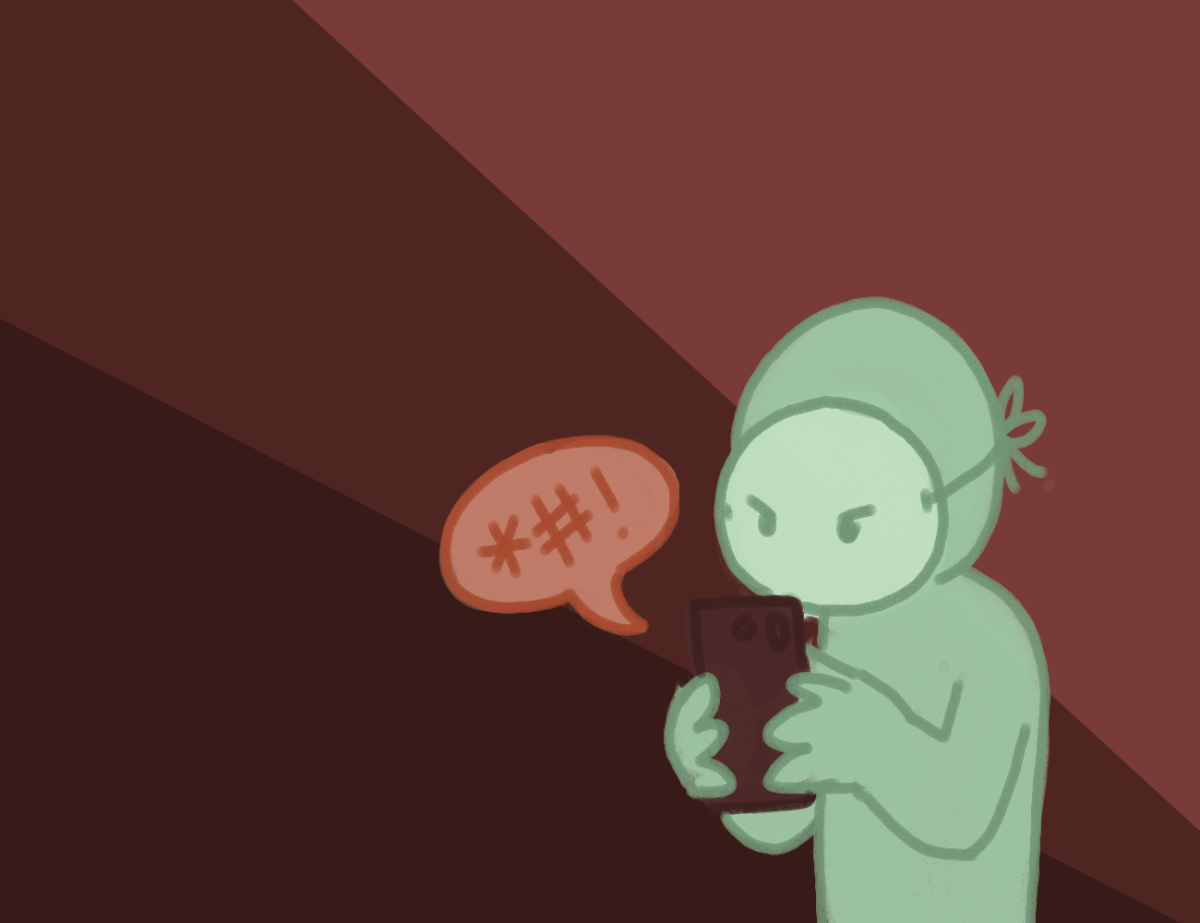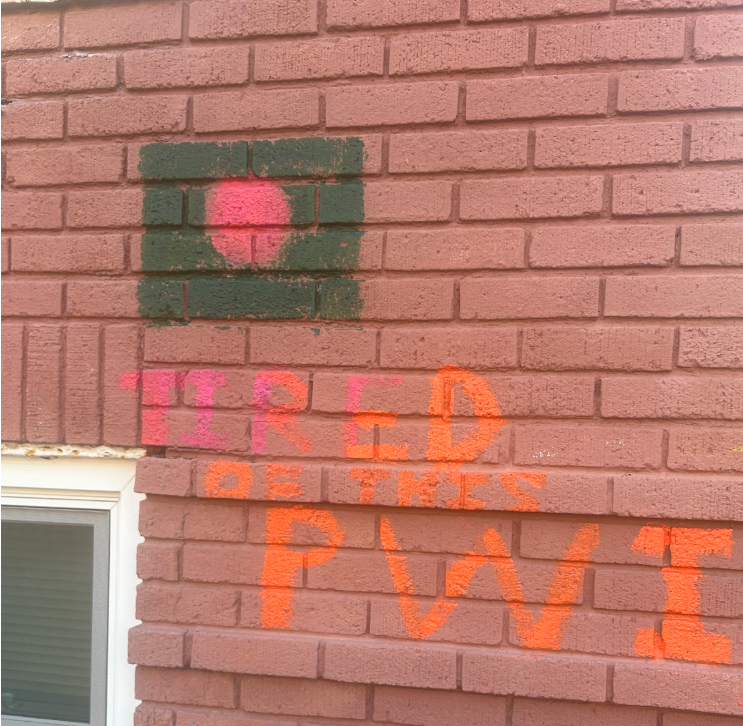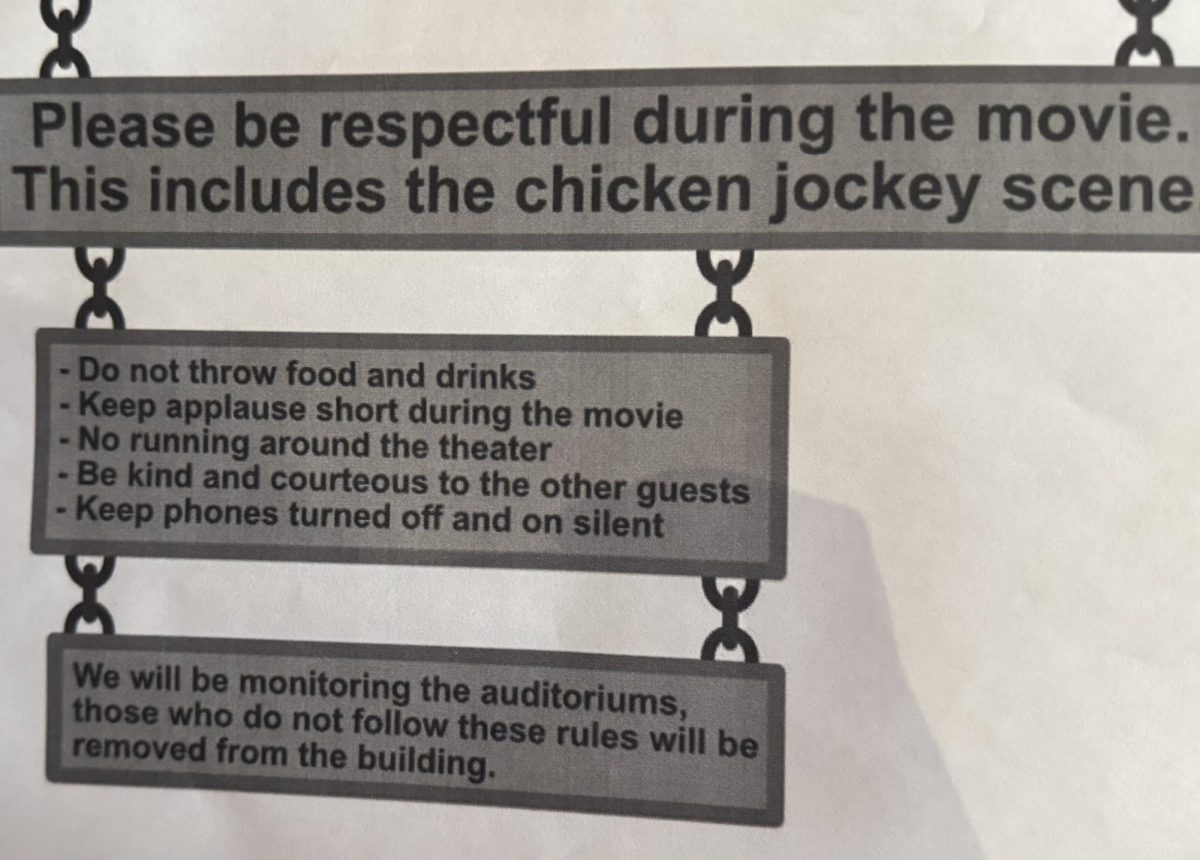By Henry Aoki [email protected]
The Nov. 16 walk-in, like most Macalester protests, was burdened by a cloak of fatigue. Cynicism echoed around the campus — emerging, even, in the walk-in’s speakers. What was the point of it all? The appearance of a swastika is a semesterly tradition, and we have yet to uncover a single perpetrator. Few students of color, as far as I could tell, doubted the futility of the event.
This cynicism was only partially shared by white students. Some were confused, mystified that Macalester could house a symbol of hatred. Many did not care; the perpetrator, they reasoned, was not a white supremacist but an idiot (a more palatable possibility). Whatever the white response, it was distinct from an expression of fatigue.
It should be absurd that we are resigned to the appearance of a swastika. Macalester has a miniscule population of 2000 students — can we not expect 2000 students of an ‘elite’ liberal arts college to simply not draw a swastika? Yet our resignation is entirely reasonable. Even such a meager endeavor would tear at the limits of the white institution. In his campus-wide announcement, President Brian Rosenberg expressed anger at “the presence of… hateful language on our campus, and… that anyone at Macalester should be made to feel unsafe.” I believe the President’s words, but I find them wanting. Swastikas are not the full extent of ‘hateful language’ on campus. Students of color are regular recipients of uncomfortable questions, arrogant assertions, supposed ‘jokes’ and outright slurs. Genocide belongs to it’s own circle of hell — but who believes that the swastika’s scribbler is attempting genocide? As President Rosenberg said, the presiding issue is that the swastika makes people feel unsafe. But hundreds of white Macalester students make students of color feel unsafe every day. They have no need to hide themselves. President Rosenberg does not confront their behavior in campus-wide emails — he hands them a degree after four years.
There is a genuine fury that the swastika made people feel unsafe. But whose safety is the primary concern? It is not only students of color and Jewish students who were affected by the swastika. A number of white students were shocked by its presence — “Macalester,” they exclaimed, “is a liberal institution!” Macalester offers white students the idea of ‘diversity.’ A public swastika tears at that idea — it unsettles white students with the possibility that they remain complicit in a racist system. The administration has since concealed the swastika, reasoning that its scribbler is only seeking attention. The endeavor does little for students of color, who continue to suffer from a thousand other avenues of racism — it is even counterproductive, for the swastika was public proof of their struggle. But hiding the swastika can greatly comfort white students — who are safe, again, from seeing the reality of racism.
The swastika’s scribbler has yet to be found. But what happens if they are? If they are a neo-Nazi, and their swastika a political statement, I assume they will face expulsion. They could be an uninformed agitator, attempting to poke the bear without understanding the symbol’s deeper meaning. They might receive an anti-racist workshop. And what if the perpetrator is a ‘minority’? I can imagine white students immediately dismissing the significance of the campus’ swastika. Perhaps the college will instead ‘start a discussion’ about self-hatred (whiteness will be exorcised of responsibility). Nothing, of course, that the institution does can retroactively remove the pain and anxiety the swastika inflicted, with one exception: they can assuage white students’ fears that something is irredeemably wrong with whiteness.
Macalester is often named as a liberal institution. The meaning of this is vague, and differs from person to person. Practice provides a different, more specific description: Macalester is a white institution. This is knowable partly through demographics: the whiteness of the student body is only outmatched by the whiteness of the faculty. But the far more damning evidence is the institution’s actions. Macalester concealed the swastika to benefit white students, at the expense of everyone else. And such is the marker of the white institution.
A white institution requires no malice towards people of color, only an absolute prioritization of white interests. White people are not monolithic; their desires often diverge. It just so happens that the majority of white people at Macalester are white people with an interest in diversity. Opposing white interests have been marginalized, although not beneath the needs of people of color. That would surpass the limits of the white institution. Instead, the white campus constantly demands the inclusion of conservative perspectives—white solidarity transcends ideology.
“The responsibility of healing this divide, like all others, is left to students of color. Some take this responsibility willingly, but the task is ultimately futile. The institution is the source of tension. We are not our problem.”
The interests of white progressives do not serve the needs of students of color. White guilt is not altruistic; the white-progressive demand for people of color to teach them is self- indulgent. Perhaps there exist white progressives whose motives are wholly self-sacrificing, but they are not in abundance. In any case, Macalester College does not screen for purity. If Macalester is to market itself as a ‘diverse’ institution, it must recruit white people who value ‘diversity,’ regardless of their motivations.
The white notion of diversity is akin to Ptolemy’s solar system; everything revolves around whiteness. Students of color are present, but always in the minority. The alternative is unimaginable. A mere 26 percent of domestic students at Macalester are people of color (comprising only twenty percent of the entire student body). There is no reasonable lens through which a domestic student body that is seventy-four percent white can be considered diverse; half of all U.S. millennials are people of color. Macalester has maintained this composition for a decade, yet still advertises itself as a multicultural institution. But it is, quite legitimately, a white multicultural institution.
The white notion of diversity, after confining students of color to a perpetual minority, then extracts from them a tax: students of color are burdened with excess responsibilities. They must first enrich the white experience; overlooking offenses and educating the uninformed. I hear the institution’s voice constantly: “Do not expect too much from white students. They’re inexperienced with racism—they simply need (and want) help understanding. Grant them a few mistakes. Be a patient teacher and they’ll transform into respectful allies. But be too strict and they won’t even try to learn.” I do not necessarily disagree. A few white students are hopeless, but most have some genuine desire to improve. My issue, however, is that Macalester has yet to cut me a paycheck for teaching. And I will not purchase my education through servitude to a confused white person.
Their second task is to reproduce the facsimile of diversity; students of color, out of self-interest and the administration’s urging, must facilitate the recruitment of more students of color. There is a hope that the white institution can be turned on itself; that the white notion of diversity might give way to a truer diversity — but the transformation is eternally forthcoming. There is only enough time to continue the recurrence. Such is the limit of the white institution.
Even the actual diversity of the institution is corrupted by the white imagination. Even now, I write as if ‘students of color’ were a singular entity, for the white spectre forces all black, asian, latinx, indigenous, and mixed experiences into one amorphous being. The term could be used as a means of solidarity — but white eyes obfuscate. The institution pretends a latinx student has no need for fellow latinx students, as if any student of color is an equal substitute. And once the distinctions between racial groups are obscured, the distinctions within racial groups are utterly unknowable. The uncomfortable truth is that the students of color at Macalester are often the most privileged students of color — often international, or of international families (this being distinct from coming from a family of immigrants), or (like me) wealthy, or (also like me) half white. I wonder how many black students at Macalester are neither mixed nor of African (not African-American) descent. But the white institution cannot begin to consider the distinctions of privilege within communities of color.
The failures of the white notion of diversity are continuous. It is curious to see that latinx students, classified as ‘hispanic’ in Macalester’s institutional data, rose from 72 students in 2006 to 126 in 2015, while black representation declined from 83 students to 45 in the same period. The differences are near equal — it suggests that Macalester substituted latinx students for black students. It should also be noted that ‘latinx’ and ‘Hispanic’ refer to ethnicities — there are white latinx and black Hispanics. For recording purposes, ‘latinx’ only means that one’s family either lives in or immigrated from Latin America. The descendants of Germans that fled to Argentina after World War II are ‘latinx.’ ‘Hispanic,’ the term Macalester uses, is even more inclusive — it technically includes any part of the former Spanish empire, including Spain itself. But Macalester counts all as people of color. The majority of ‘Hispanic’ students on campus are not racially white — but some may be, and they would have replaced black students.
It may sound like I am attempting to turn people of color against other people of color. I am not; Macalester has done that already. Committed to upholding an arbitrary quota, the institution wielded latinx students as a weapon against black students. If there is ever an attempt to enroll the most underprivileged students of color, it will be accompanied by a reduction in privileged students of color. The white majority cannot be jeopardized.
This alone is only a fraction of the white institution. Its spaces are charged, polarizing its students. Every community of color at Macalester fractures across politics and personality — ‘whitewashed’ and ‘performative’ are opposite insults. This should come as no surprise. One can feel the spectre of the white institution leering at one’s body. The stress drains the soul; distrust refills it. Isolation is infectious; familiar faces begin to evoke fear — what if they are only masks? Safety is guaranteed only by constant policing, but such a state does not allow for community. And the responsibility of healing this divide, like all others, is left to students of color. Some take this responsibility willingly, but the task is ultimately futile. The institution is the source of tension. We are not our problem.
A white institution cannot purge the rot from whiteness; its whiteness is an inherent limitation. If an institution is to serve the needs of people of color, it must cease to be white. This process is possible, although perhaps not feasible. But I believe it can be done. Macalester consists of a mere 2000 students, 85 percent of which are domestic (international students belong to a distinct racial context). In practice, there are 1300 white domestics, and 500 domestic students of color. Would it be so difficult, over four years, to replace 400 of those white students with students of color? This is an extremely modest goal — but it would begin to challenge the whiteness of the institution. It offers, furthermore, a chance to disrupt the crass substitution of demographic for another — the diversity of students of color will always be limited by the amount of students of color.
We could aim ever higher. If Macalester maintained a population of 1800 domestic students, the plurality of whiteness would be eliminated by recruiting 360 students from each racial group—black, asian, indigenous, and latinx (setting aside, briefly, the complexity of identifying ‘latinx’ as a race). This would only mean recruiting 90 from each racial group per year. It would be an undoubtedly difficult endeavor, requiring a sizeable budget and a significant reallocation of the current recruiters, but it is not impossible. Macalester is not a poor college.
That alone would not end the white institution. The faculty requires a greater transformation (it far exceeds the whiteness of the students), and it will be far more difficult. There are far less prospective professors of color than there are prospective students. And even untenured professors may not be as easily replaced as the ever cycling crop of students. But a composition wherein professors of color are 25 percent of tenure/tenure-track faculty and only 18 percent of non-tenure track faculty has feasible room for improvement. Recruitment alone is inadequate — Macalester has a near perennial tradition of being sued by professors of color for discrimination. And the last year has seen a strangely high turnover among people of color in non-teaching positions. The demolition of the white institution will demand an active campaign against racial harassment and hostility.
The backlash against even the humblest proposals will likely be extensive. White people — students and faculty — will lose a great deal of privilege. Such privilege is both the foundation and the substance of the white institution. Backlash is itself an expression of the white institution: the continued prioritization of white interests over the needs of people of color. The white institution is nothing if not self-preserving.
The eventual, coalesced counterargument that I can picture will be an appeal to Macalester’s nature. It will charge that such a transformation is impractical, for the expenditure will diminish the institution’s essence of eliteness. The less politically correct will claim this out of a mistaken belief that no substantial number of students of color can be elite; the more thoughtful will argue that the economic costs of diversification can only be compensated through a decline in Macalester’s educational resources. I am more optimistic; but I will not assume the latter are wholly incorrect.
The assumed problem is that the destruction of the white institution risks the diminishment of whatever else Macalester is — a ‘progressive,’ ‘elite,’ private liberal-arts college. It presents itself as reasonable concern — but such is the limit of the white institution. None of the college’s other aspects exist independent of its whiteness. I have already outlined the limitations of white progressivism. Its ‘eliteness’ is a tool of inequality — the chief function of the college’s pedigree and connections has been the reproduction of white wealth. The minority of students of color are granted the opportunity to skim from this white wealth — but said students are often the most privileged to begin with. There is only a pyrrhic victory in leeching off of inequality — any success justifies the inequality. The whiteness of the institution lacks any silver lining.
But do these truths trouble the white, ‘progressive’ institution? A hastily scribbled swastika drew white outrage — there is no such fury over Macalester’s tokenization of students of color. A constant state of inequality does not appear to make white students feel ‘unsafe.’ Perhaps we could change this. What if students of color publicized every instance of our racial unease — and without any of the usual obliqueness in our retellings? We already share them with our friends; why not with the community at large? The white institution expects each student of color to be a sponge — absorbing four years of discomfort and abuse; let us instead unveil a mirror. Let them see the crude facsimile they call ‘diversity.’ White students flocked to protest over a swastika etched on a wall —l et them discover the swastika inscribed upon their campus. It may not be able to push them far enough. But they came to Macalester seeking some ‘liberal’ college. At the very least, let us not allow them the white blanket of self-security. Let us show them the limits of the white institution.







Carol Slater • Sep 10, 2019 at 7:05 pm
I always was concerned in this topic and still am, thankyou for posting.
Claire Butler • Sep 7, 2019 at 3:24 pm
This information is priceless. When can I find out more?
Meara Madison • Jan 30, 2018 at 9:44 pm
Thank you for writing this.